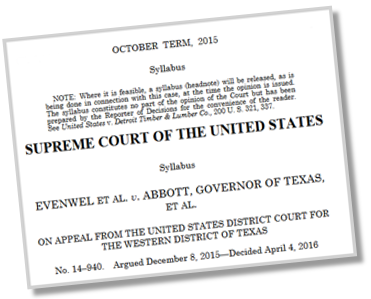April 4, 2016 •
One Person, One Vote Ruling by U.S. Supreme Court
 Today, the U.S. Supreme Court unanimously decided a state or locality may draw its legislative districts based on the total population of all people rather than based on only the population of registered voters.
Today, the U.S. Supreme Court unanimously decided a state or locality may draw its legislative districts based on the total population of all people rather than based on only the population of registered voters.
In Evenwel v. Abbott, appellants argued apportionments based on total population for drawing Texas Senate legislative districts diluted their votes in relation to voters in other state Senate districts. They argued such dilution was a violation of the one-person, one-vote principle of the Equal Protection Clause.
While the Court found the apportionment was constitutionally drawn, the decision, written by Justice Ruth Bader Ginsburg for six of the Justices, explicitly stated it does not address whether “states may draw districts to equalize voter-eligible population rather than total population.” Justices Clarence Thomas and Samuel Alito each issued separate concurring opinions. The Court decision is available here.
State and Federal Communications, Inc. provides research and consulting services for government relations professionals on lobbying laws, procurement lobbying laws, political contribution laws in the United States and Canada. Learn more by visiting stateandfed.com.

